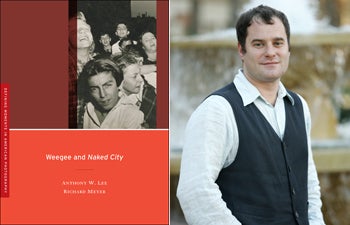Naked Hollywood
In 1951, when bombshell actress Jayne Mansfield publicly dropped the top of her dress, the photographer Arthur Fellig, also known as “Weegee the famous,” was there to capture the moment on film.
The caption to Weegee’s photo reads, “American movie star Jayne Mansfield (1933 – 1967) draws attention to herself during an evening out in Hollywood, California.”
“In other words,” said Richard Meyer, associate professor of art history in USC Dornsife, “Mansfield felt that not enough people were looking at her as she walked down Hollywood Boulevard. So she dropped her top to make them to look.”
Meyer, who co-wrote Weegee and Naked City (University of California Press, 2008), has been tapped to curate “Naked Hollywood: Weegee in Los Angeles, 1946–1955,” a major exhibition at the Museum of Contemporary Art in Los Angeles (MOCA) opening in November 2011.

USC Dornsife’s Richard Meyer co-wrote Weegee and Naked City, published by University of California Press in 2008. In the book, Meyer looks carefully at Weegee’s photographs before and after they were collected and assesses how his practice of tabloid photography was inseparable from the photographer’s own lowbrow appeal. Meyer photo by Phil Channing.
The Mansfield image is among 250 photographs to be displayed in “Naked Hollywood,” most of which have never before been shown or reproduced. This is the first museum exhibition devoted to the body of work Weegee created in Southern California. Following the photographer’s lead, the exhibition will document the lurid, irresistible undersides of stardom, fandom, commerce and self-promotion in mid-century Los Angeles.
In addition to the photographs, the exhibition will encompass Weegee’s related work as an author, filmmaker and photo-essayist.
“Weegee saw things that other photographers don’t notice,” Meyer said. “Instead of taking only photos of the stars, he captured images of the crowd watching the stars, the looks of disappointment on their faces when they didn’t get autographs.
“He thought about public space. When he stood on Hollywood Boulevard he thought about what that meant at that point in time. He took photos of homes that no one watching the stars could possibly afford. He took a photo of a funeral parlor advertisement on a bench — the last thing the stargazers would want to think about. He brought out all sorts of irony.”

Actress Jayne Mansfield garners more attention as she strolls down Hollywood Boulevard in 1951 by dropping her top and exposing her bra. Photo by Arthur Fellig known as “Weegee.”
The exhibition will be presented in conjunction with “Pacific Standard Time: Art in L.A. 1945–1980,” a series of 26 concurrent museum exhibitions throughout Southern California highlighting different aspects of the post-war art scene in L.A.
Sponsored by the Getty Foundation, “Pacific Standard Time” is the largest collaborative project ever undertaken by museums in the region. In joining the collaboration, MOCA Director Jeffrey Deitch approached Meyer about organizing an exhibition of photography. Meyer immediately thought of presenting the Los Angeles work of Weegee, who began as a crime photographer in New York City. Deitch agreed and Meyer became curator.
“Weegee is an incredible photographer,” Meyer said, “and several MOCA staff members including the director were already fans of his work. Plus, Jeffrey really liked the [exhibition] title.”
“Naked Hollywood” is being funded by the Annenberg Foundation.
Meyer is director of The Contemporary Project at USC, a multi-year initiative forging new dialogues between the academy and the art world, sponsored by USC Dornsife and the Roski School of Fine Arts at USC. In conjunction with his curator work, Meyer will serve as MOCA’s first scholar-in-residence, a position that will enable him to open the museum to USC graduate and undergraduate students.
In a sense, this process has already begun — two of Meyer’s Ph.D. students have been hired as research associates by MOCA to work on “Naked Hollywood” and in mid-May, Deitch gave a special tour of “Art in the Streets,” an exhibit displaying graffiti art, to students in Meyer’s undergraduate general education course, “Culture Wars: Art and Social Conflict, 1900 – the present.”